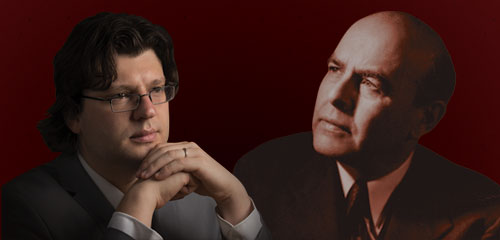Completing the Incomplete: Auguste Descarries’ Quartet by Romy-Léa Faustin
/ October 1, 2015
Version française...

What could Johann Sebastian Bach, Wolfgang Amadeus Mozart, Franz Schubert, Gustav Mahler and Auguste Descarries possibly have in common? All these composers had at least one unfinished opus, which in some cases was completed by others. This is still a trend today. Russian-born Canadian composer Aleksey Shegolev was recently asked by the Auguste Descarries Musical Association(ADMAD) to complete the Quartet for violin, viola, cello and piano written by the Québec composer, who died in 1958. This project was the subject of a lecture by Shegolev last May. The Quartet will be premiered on October 30 at Montréal Museum of Fine Arts’ Bourgie Hall.
Auguste Descarries, a composer worth discovering
Although still relatively unknown, Québec pianist and composer Auguste Descarries cannot be left out of Québec’s musical history. With this in mind, the ADMAD, founded in 2012, took on the mission “to promote the recognition and dissemination of the works of Auguste Descarries”. 1 Their mission is broken down into eight objectives, including “To inventory, locate and gather all the musical works of Auguste Descarries, whether religious or secular music, works for solo, vocal or instrumental ensembles, or works for organ, piano or full orchestra, in order to make a complete critical catalog,” and to “Promote the dissemination of Auguste Descarries’ musical works.”2 It is within this framework that the Quartet completion project was initiated.
According to Shegolev, who earned a doctorate in composition at Université de Montréal in 2014, Descarries and his compositions are of particular interest for both music lovers and musicians. “This is our heritage,” he says. “You have to play it and love it because it represents our heritage, our culture [...] The French have Debussy, Ravel and Fauré; Russians have The Five and Tchaikovsky; Italians have all those opera masters. And here, we have Rodolphe and André Mathieu, Claude Champagne, Alexis Contant and now, Auguste Descarries.”
Descarries’ compositional style is labeled neo-romantic (as are those of Rimsky-Korsakov, Rachmaninov and Medtner, to name a few), and is partly the result of having studied in Paris with Russian composers Léon Conus and Georges Catoire. So his training was not unlike what he would have received at the Moscow or St. Petersburg Conservatories. Shegolev says that Descarries’ music is aimed towards a wide audience. His works are quite accessible, despite a rather complex writing style. So they can appeal to musically trained ears as well as untrained ones.
A real challenge
The Quartet for violin, viola, cello and piano was written in 1934, in one movement of complex form. The work uses many themes throughout a texture that is sometimes contrapuntal, sometimes an accompanied melody, which eventually lead to a cadence that leaves the opus incomplete. Shegolev outlines his approach to completing the work in four steps:
1. Understanding and classifying all the thematic material used by Descarries in the work
2. Studying the composer’s writing style and harmonic language in order to imitate it later on
3. Balancing the piece so that the new section is neither too short nor too long in relation to the rest
4. Finding an interesting conclusion.
In describing the different phases of his work, Shegolev highlights one particular difficulty: “I had to imitate Descarries, who himself imitated Russian post-Romantic composers such as Scriabin, Rachmaninov and Medtner; this can be a rather delicate matter.” On the question of form balance, his choices were guided above all by his experience and knowledge. About the ending, he adds: “The longer the piece, the more satisfactory the end should be [...] You have to give the listener a good reason to applaud.”
The biggest challenge? “Working with a handwritten score, which implies that the text did not go through a real editing filter, and has many errors, omissions, inconsistencies of nuance, rhythm and especially alterations”. To overcome this obstacle, Shegolev had to rely on his knowledge of musical writing and analysis. When asked if his Russian origins helped him to meet this challenge, the young composer responds enthusiastically, “Of course! [...] It was not too difficult to link Descarries’ writing style with those of late nineteenth-century Russian composers. The harmonization techniques, the way the piano is orchestrated, the Medtner-style polyrhythm and many other aspects of Russian music, I recognize them in Descarries’ writing. Without this knowledge, it would be much more difficult for me to complete this piece.”
Despite all these difficulties, it seems Aleksey Shegolev was able to complete a project he is proud of. Although his lecture on May 20, 2015 was successful, it’s nevertheless on October 30 that his work will likely be put to the test; the audience’s applause will be his ultimate reward.
Descarries’ Quatuor pour violon, alto, violoncelle et piano will be premiered at the concert “Mathieu, père et fils” by Trio Hochelaga at Bourgie Hall, October 30 at 6:30 pm. www.sallebourgie.ca
1 Association pour la diffusion de la musique d’Auguste Descarries (1896-1958), www.associationaugustedescarries.com
2 idem
Version française... | |

